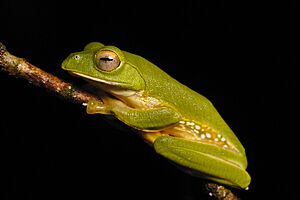Anaimalai flying frog facts for kids
Quick facts for kids Anaimalai flying frog |
|
|---|---|
 |
|
| Conservation status | |
| Scientific classification |
The Rhacophorus pseudomalabaricus, also known as the Anaimalai flying frog, is a special type of frog that belongs to the family Rhacophoridae. It's called a "flying frog" because it can glide through the air using its webbed feet! This frog is found only in the Anaimalai Hills in southern India, which are part of the Western Ghats mountain range. You can find it in the Tamil Nadu and Kerala states.
Contents
Meet the Anaimalai Flying Frog
These amazing frogs have some unique features.
- Adult male frogs are about 4.7 to 5.4 centimeters (1.8 to 2.1 inches) long.
- Adult female frogs are a bit bigger, measuring 6.6 to 7.2 centimeters (2.6 to 2.8 inches).
- They have eyes that stick out.
- Their fingers and toes are covered in wide webbing, which can be light yellow or even red-orange. This webbing helps them glide!
Amazing Camouflage
Young Anaimalai flying frogs have cool black stripes, like a zebra. As they grow older, these stripes fade. Their skin then starts to look like the veins on a leaf, and their body color is green. Scientists think this special pattern helps them blend in with leaves, making it harder for predators to spot them. It's a perfect example of camouflage in nature!
Where They Live and How We Protect Them
The Anaimalai flying frog lives in different kinds of forests.
- You can find them in tropical moist evergreen forests, which are always green and wet.
- They also live in forests that are growing back after being used for farming, like old cardamom plantations.
- Sometimes, they are found near streams or even man-made water holes.
- These frogs can be seen high up in the trees or closer to the ground.
- They live at elevations from about 955 to 1,430 meters (3,133 to 4,692 feet) above sea level.
Frog Neighbors
Scientists have a neat trick to tell the Anaimalai flying frog apart from another similar frog, R. malabaricus. The R. malabaricus usually lives closer to sea level, while our Anaimalai flying frog prefers higher places!
Family Life of the Frog
When it's time to have babies, these frogs get creative!
- They reproduce on plants that hang over wet areas like marshes, ponds, or streams.
- The male frog makes a call that sounds like "trrr tik tik tik tik trrrr" to attract a female.
- The female frog builds a special "foam nest" using her back legs and a fluid from her body.
- She lays her eggs in this foamy nest, and the male fertilizes them.
- After the eggs are laid, the female uses her front legs to cover the nest with leaves or grass. This keeps the eggs safe!
Protecting Their Home
The Anaimalai flying frog lives in at least two special protected areas:
- Indira Gandhi National Park
- Parambikulam Tiger Reserve
However, outside these safe zones, their homes are in danger.
- Forests are being cut down to make space for farms or other uses.
- Trees are also being removed for timber.
- Some forests are even turned into places for animals to graze.
Challenges for the Frogs
Some local farmers who grow cardamom believe these frogs eat their crops. Because of this, they see the frogs as pests. Scientists are still studying this to see if it's true. Sadly, some farmers try to get rid of the frogs. There's also a local belief that seeing this frog can bring bad luck.
Another big problem is that these frogs are sometimes caught and sold illegally as pets. This can harm their populations in the wild.
Images for kids



